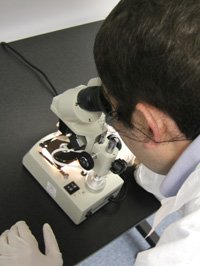What is a Data Recovery Clean Room?
A clean room is a work area with controlled temperature and humidity to protect sensitive equipment from contamination. Common features include plastic walls and ceilings, external lighting, and a continuous influx of clean, dust-free air. The room must be cleaned daily to prevent contamination.
Many different industries require the use of a clean room. Medical facilities, integrated circuit manufacturers, and dairy farms are just a few of the most notable examples, and most data recovery laboratories have at least one Class 5 clean room on site (ISO 14644-1).
Clean room technology is essential for performing basic recovery procedures. For example, any physically damaged hard disk must be recovered in a clean room to preserve the initial state of the media. Without a clean room, contaminants can settle on the platters, which can affect the data recovery process; after the hard disk’s platters have become contaminated, the heads can catch on the foreign particles, scratching the platter surface and resulting in permanent data loss.
Why are Clean Room Classifications Important?

Clean room design must include strict controls for environmental conditions in order to ensure consistent air quality and a low particle count. The environmental conditions in a clean room are controlled by particle enclosure during installation of the wall, floor, ceiling and media. Later, particle sources cannot be easily removed and the newer particles could cause contamination.
Clean room classifications help to demonstrate the effectiveness (or ineffectiveness) of these controls. The exact equipment used in a clean room environment depends on the level of cleanliness required. In industries where a specific level of cleanliness has been established, auditors use the ISO 14644-1 form to determine classification. Previously, and often still used in industry is the Federal Standard STD-209E, though it was cancelled for US government use in 2001.
This standard outlines the airborne particulate cleanliness classes. Class limits are given for each class name. These limits designate specific concentrations (particles per unit volume) of airborne particles found in the clean room. All data recovery clean rooms must meet Class 5 standards; less strict standards offer insufficient protection. Stricter standards are not necessarily “better” for data recovery work, as there has never been a single incidence of platter contamination in Datarecovery.com’s clean rooms.
ISO 14644-1 Airborne Particulate Cleanliness Classes
| class | maximum number of particles per cubic meter of air of diameter greater than or equal to each indicated size | typical uses | |||||
|---|---|---|---|---|---|---|---|
| 0.1 µm | 0.2 µm | 0.3 µm | 0.5 µm | 1.0 µm | 5.0 µm | ||
| 1 | 10 | 2.37 | 1.02 | 0.35 | 0.083 | 0.0029 | |
| 2 | 100 | 23.7 | 10.2 | 3.5 | 0.83 | 0.029 | |
| 3 | 1,000 | 237 | 102 | 35 | 8.3 | 0.29 |
|
| 4 | 10,000 | 2,370 | 1,020 | 352 | 83 | 2.9 | |
| 5 | 100,000 | 23,700 | 10,200 | 3,520 | 832 | 29 |
|
| 6 | 1 x 106 | 237,000 | 102,000 | 35,200 | 8,320 | 293 |
|
| 7 | 1 x 107 | 2.37 x 106 | 1,020,000 | 352,000 | 83,200 | 2,930 |
|
| 8 | 1 x 108 | 2.37 x 107 | 1.02 x 107 | 3,520,000 | 832,000 | 29,300 |
|
| 9 | 1 x 109 | 2.37 x 108 | 1.02 x 108 | 35,200,000 | 8,320,000 | 293,000 | |
Federal Standard 209E Airborne Particulate Cleanliness Classes
| class | maximum number of particles per cubic foot of air of diameter greater than or equal to each indicated size | typical uses | ||||
|---|---|---|---|---|---|---|
| 0.1 µm | 0.2 µm | 0.3 µm | 0.5 µm | 5.0 µm | ||
| 1 | 35 | 7.5 | 3 | 1 | — |
|
| 10 | 350 | 75 | 30 | 10 | — | |
| 100 | — | 7502 | 300 | 100 | — |
|
| 1000 | — | — | — | 1000 | 7 |
|
| 10000 | — | — | — | 10000 | 70 |
|
| 100000 | — | — | — | 100000 | 700 |
|
Additional Requirements for a Data Recovery Clean Room
A shell encloses the clean room, separating the clean air from the rest of the building. The shell is ventilated with filtered air during construction to prevent contamination. To help guard against leakages in the system, the Filter Fan Concept aids in the re-circulation of about 96% of the total air volume within the clean shell. This technology also ensures high flexibility.
Clean rooms must be controlled and monitored very closely during construction, start-up, and operation. Extensive measuring and testing must be done periodically to ensure that the clean room is running properly.
Clean room operators are required to wear special non-linting body-suits, overshoes, gloves, head coverings and masks. In some clean rooms, workers even pass through an air blast upon entering to remove particles and ensure minimal contamination of the environment.
All of Datarecovery.com clean rooms and clean-flow benches are certified regularly to meet NEBB Clean Room Standards. To learn more or to start a case, call us today at 1.800.237.4200.





